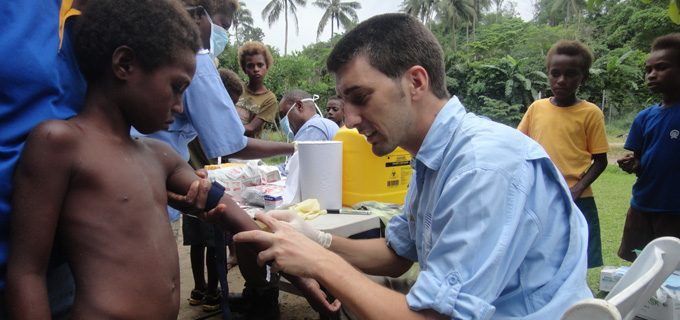One Step Closer to Eradicating Yaws
Prestigious New England Journal of Medicine to publish the results of a study led by ISGlobal researchers demonstrating the effectiveness of the WHO's yaws eradication strategy
19.02.2015
On 19 February, the prestigious New England Journal of Medicine will publish the results of a study led by ISGlobal researchers that demonstrates the effectiveness of the strategy proposed by the World Health Organization (WHO) to eradicate yaws by 2020. One round of mass treatment with single-dose oral azithromycin was shown to greatly reduce the transmission and prevalence of yaws on Lihir Island of Papua New Guinea. The results of this study provide empirical data to support the Morges yaws eradication strategy proposed by WHO in 2012. ISGlobal provides a hub of excellence dedicated to scientific research and the provision of health care. The institute, which originated in a joint initiative of the Hospital Clínic de Barcelona and the University of Barcelona, is financed by "la Caixa" Foundation and the Governments of Spain and Catalonia.
From April 2013 through May 2014, the research team implemented a mass treatment programme that covered all 28 villages of Lihir Island, an area with a very high burden of yaws infection. Every resident older than two months of age was offered a single oral dose of azithromycin. The overall treatment coverage rate was 84% of the estimated population of 16,092 people. After the initial mass treatment campaign, researchers returned to the villages every six months to screen for cases of active yaws through clinical skin examination of every resident person at the time of the survey. At the end of the study, they found that the prevalence of yaws had fallen from 2.4% before treatment to 0.3% at 12 months. They also found that the percentage of participants with latent yaws (disease carriers) decreased from 18.3% to 6.5%.
"This study provides empirical data demonstrating that one round of mass treatment significantly reduced the prevalence of disease and transmission in the villages," commented ISGlobal researcher Oriol Mitjà, the lead author of the paper. "Although a sustained active surveillance and treatment effort will be necessary to achieve zero yaws cases, our data confirm that the WHO strategy has the potential to eradicate this disease."
Azithromycin is a cheap and effective antibiotic that is easy to administer. The generic form used in this study costs USD 0.17 for a 500mg tablet, in doses of up to 2g. In 2012, an ISGlobal team formed by Oriol Mitjà and Quique Bassat showed for the first time that a single oral dose of this antibiotic is enough to cure a person with yaws. On the basis of this discovery and other information, the WHO developed the Morges strategy and set 2020 as the target year for yaws eradication.
Yaws is a chronic neglected tropical disease that is related to syphilis, but is transmitted, mostly among children, by nonsexual skin to skin contact. It primarily affects the skin and bones of children and can cause severe bone deformities in the long term. This highly contagious infection is prevalent in 13 very poor countries in areas where people have little access to healthcare services and live in poor hygienic conditions. The WHO's current target is the eradication of yaws—that is, zero cases worldwide—by 2020.
Reference: Mitjà O, Houinei W, Moses P, Kapa A, Paru R, Hays R, Lukehart S, Godornes C, Vivaldo Bieb S, Grice T, Siba P, Mabey D, Sanz S, Alonso P, Asiedu K, Bassat Q. Mass Treatment with Single-Dose Azithromycin for Yaws. N Engl J Med 2015; 372:703-10.
Documentary
The Broadcaster producer has started the filming of a documentary on the eradication campaign and Dr Oriol Mitjà's story.
Teaser available: http://www.broadcaster.cat/pian



